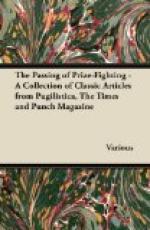We have thought it due to the full consideration of our subject so far, to dwell upon the natural difference between the skull of a Peer and the skull of a Commoner. The skull of the noble, as we have shown, is a thing made to order—fitted up, like Mr. MECHI’S pocket-dressing-case, with the ornamental and useful: no instrument can be added to it—the thing is complete. Hence, to employ historical painters for the education of the House of Lords would be a useless and profligate expenditure of art and money. It would be to paint the lily LONDONDERRY—to add a perfume to the violet ELLENBOROUGH. All Peers being from the first—indeed, even in utero—ordained law-makers, statute-making comes to them by nature. How much history goes to prove this, showing that the House of Lords—like the Solomons of the fleur-de-lis—have learned nothing, and forgotten nothing! To attempt to instruct a Peer would be as gross an impertinence to the instinct of his order as to present MINERVA—who no doubt came from the head of JOVE a Peeress in her own right—with a toy alphabet or horn-book.
For the skulls of the House of Commons,—that is, indeed, another question! We are so far utilitarian that we would have the pictures for which Mr. BARRY offers a thousand feet selected solely with a view to the dissemination of knowledge amongst the many benighted members of the House of Commons. We would have the subjects so chosen that they should entirely supersede Oldfield’s Representative History; never forgetting the wants of the most illiterate. For instance, for the politicians on the fifth form, the SIBTHORPS and PLUMPTRES, whose education in their youth has been shamefully neglected, we would have a nice pictorial political alphabet. We do not pride ourselves, be it understood, upon writing unwrinkled verse; we only present the subjoined as a crude idea of our plan, taken we confess, from certain variegated volumes, to be had either of Mr. SOUTER, St. Paul’s Churchyard, or Messrs. DARTON and HARVEY, Holborn.




